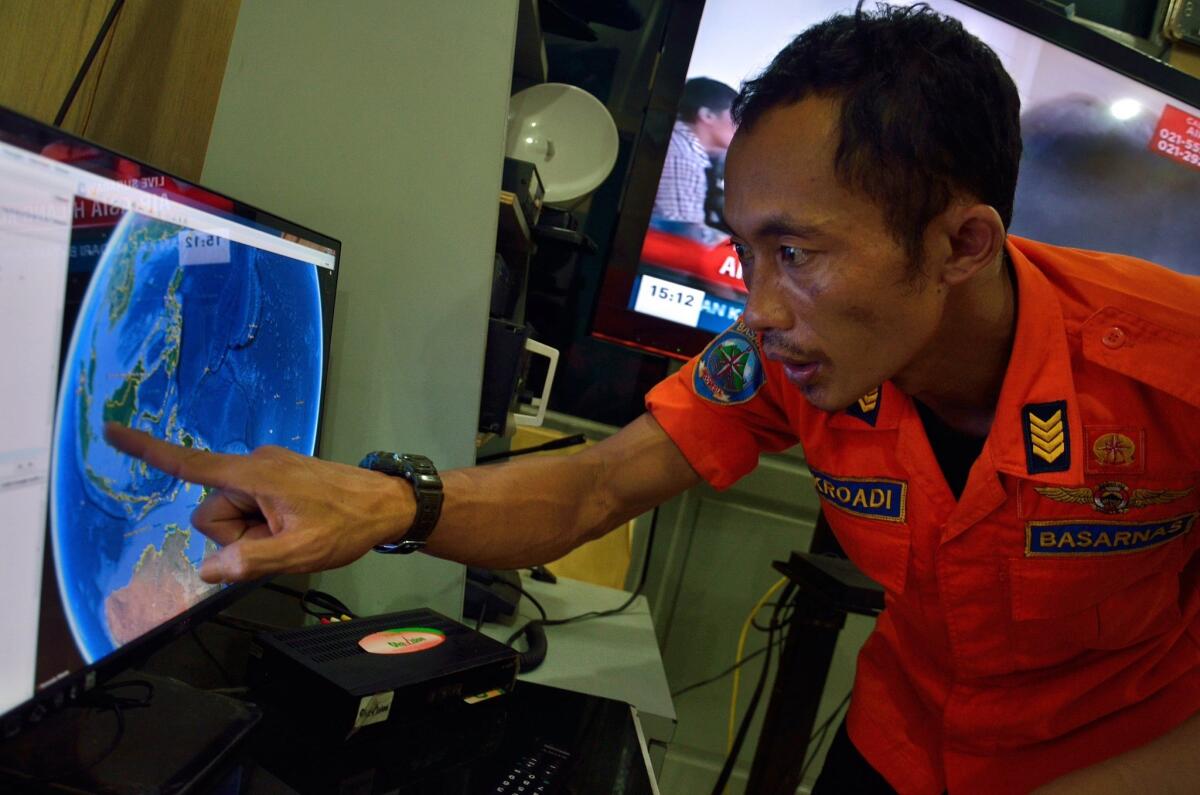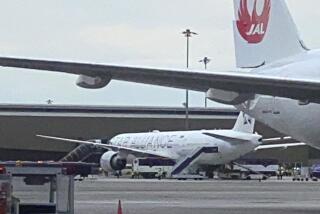AirAsia flight: Weather is only one factor investigators will check

- Share via
The AirAsia jetliner that went missing over the Java Sea early Sunday was traveling a route packed with turbulent thunderstorms and lightning strikes, prompting questions about whether the jet’s last transmission -- a request to change its altitude to avoid clouds -- could provide a clue to its disappearance.
But analysts stress that there is far too little information available yet to determine if weather played a role in the jet’s disappearance.
Thunderstorms had been recorded along the flight path of AirAsia Flight 8501 when it went missing more than half an hour after takeoff. Airline officials said 155 passengers and seven crew members were aboard.
No wreckage was discovered before investigators suspended their search overnight in an area with severe weather. The plane had been heading from the Indonesian city of Surabaya to Singapore.
The storms in the area -- during what is said to be the wettest time of the year for Indonesia -- have received much initial attention as a possible culprit. “The storms in the area were capable of producing severe turbulence, strong wind shear, frequent lightning and icing,” according to an AccuWeather.com meteorologist.
Pilots especially fear strong winds and heavy turbulence, which can cause loss of control or damage to the plane.
But experts say storms don’t often cause plane crashes for a simple reason: Pilots avoid bad weather in the first place.
“Every airline has a meteorology department; they will check the weather and plan the flight before takeoff to avoid [strong storms],” said Anthony Brickhouse, associate professor of aerospace and occupational safety at Embry-Riddle Aeronautical University in Daytona Beach, Fla.
If storms pop up during a flight, pilots will consult on-board or on-the-ground weather sensors and change course and/or altitude, Brickhouse said. “You will divert around it, mainly to give the passengers a smoother ride.”
“Planes are designed to be extremely strong,” Brickhouse said. “However, when you get into severe weather or a thunderstorm, there could really be some severe forces inside those cells.”
After a series of crashes in the 1980s and ‘90s -- typically during takeoff and landing when planes face unpredictable winds -- Brickhouse said the airline industry has made “sweeping changes” to update plane sensors and provide the kind of information to pilots that could prevent similar accidents.
“It’s really rare for an aircraft to encounter weather in-flight and it end up in an accident,” Brickhouse said, in discussing the missing AirAsia flight.
The Indonesian transport ministry said the last communication from the Airbus A320-200 jetliner came when the pilot asked permission to climb to an altitude of 38,000 feet to avoid clouds; six minutes later, the flight disappeared from radar.
Keith McGuire, a former National Transportation Safety Board investigator, agreed that too little information is yet available to determine whether the weather could be a factor in the disappearance.
In his 27 years as an investigator for the NTSB, McGuire said, he came to notice a pattern in how the public and the media focus on a plane crash. “Every day, there’s a new theory that comes out about what happened,” McGuire said. “Today, maybe it’s the weather, tomorrow, maybe it’s something else.”
The public is not alone: McGuire said investigators have to fight to maintain objectivity while investigating a crash. “I think every accident I’ve been involved in, there was a moment” where he had a strong hunch about what happened, McGuire said. “But the vast majority of the time it wasn’t any of those things -- it was something else.”
Some high-profile crashes in recent years have shown how weather may not be directly involved in causing a crash but can instead set off a complex series of pilot and mechanical failures that end with a crash.
When an Air France Airbus A330 jet went missing between Brazil and Paris in 2009, initial reports suggested that the plane might have passed through thunderstorms with 100-mph winds.
But after a lengthy investigation, the crash was ultimately blamed on an intricate series of events that involved a sensor being blocked by ice and the crew’s failure to recognize the problem and respond properly.
“That might be an example of what you’re talking about when you think it’s weather but it’s something else,” McGuire said.
The same year, a Colgan Air Bombardier DHC-8-400 crashed near Buffalo, killing 49 people on board and one person in a house on the ground. The plane had started to ice over before the crash.
But an NTSB investigation showed the ice was not to blame as much as the pilots, who reacted poorly when the plane went into a stall.
McGuire said gathering voice and data recorders from the AirAsia jet -- if it crashed -- would be the best sources of information when investigators start building their inquiry into what happened.
For pilots, asking what kind of punishment a plane can take from a storm is not too common, McGuire said.
“It’s never a decision of, ‘Will I survive going through something like that?’ ” McGuire said. “It’s a decision of, ‘Oh, I’ll avoid it.’ ”
Times staff writer Shashank Bengali in Mumbai, India, contributed to this report.
Follow @MattDPearce for national news
More to Read
Sign up for Essential California
The most important California stories and recommendations in your inbox every morning.
You may occasionally receive promotional content from the Los Angeles Times.














